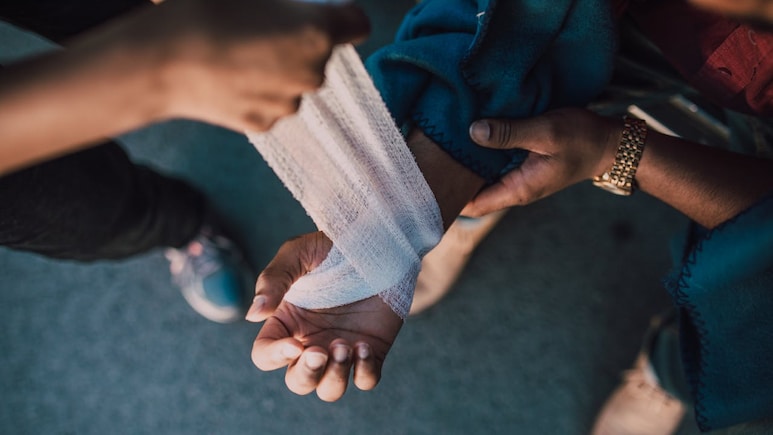
Injuries can happen anywhere, at home, on the road, or in the workplace. While some are minor, others can quickly become life-threatening if bleeding is not controlled. According to trauma experts, uncontrolled haemorrhage is one of the leading causes of preventable deaths worldwide. "The only thing more tragic than a death from bleeding is a death that could have been prevented," says Dr. Niharika Aneja, Head of the Department - Accident and Emergency Care, Manipal Hospital, Sarjapur Road. As India witnesses increasing cases of road traffic accidents, workplace injuries, and even domestic accidents, the importance of knowing basic first-aid skills becomes critical.
Stopping a severe bleed doesn't always require advanced medical knowledge. In fact, by acting quickly within the first 60 seconds, ordinary people can prevent excessive blood loss and save lives, sometimes even their own.
Here's what you should know about the basics of bleeding control and why these simple steps matter.
Step 1: Ensure Your Safety First
When faced with an accident, the instinct is often to rush to help the injured. But Dr. Aneja stresses that your own safety must come first.
"Before helping someone, assess the scene. If it's unsafe, DON'T proceed. You can't help others if you become a victim yourself. Only provide aid when it's safe to do so," she explains.
For instance, in road accidents, oncoming vehicles may pose a danger. In cases of fire or chemical exposure, toxic fumes could harm rescuers. A quick safety scan ensures you are not putting yourself at risk while trying to save another person.
Step 2: Call For Emergency Help
Even while giving first aid, professional medical help is essential. In India, dialing the government helpline 108 connects you to emergency responders.
"Call immediately and guide them to your location with clear details of the incident so that appropriate help can reach on time," says Dr. Aneja.
Providing accurate details like the number of victims, type of injury, and precise location helps ambulance teams arrive better prepared.
Step 3: Apply Direct Pressure
The most important first response to bleeding is direct pressure. This simple action slows blood loss and buys crucial time until help arrives.
"Locate the source of bleeding and cover the wound with a clean cloth or gauze. Try to press the bleeding area firmly with both hands for 5 to 10 minutes to prevent more blood loss," advises Dr. Aneja.
A common mistake is lifting the cloth repeatedly to "check" the wound. This can disturb clot formation. Instead, if the first cloth becomes soaked, place another cloth on top and continue applying firm pressure.
Step 4: Use A Tourniquet (When Needed)
In cases where direct pressure does not control bleeding from a limb, a tourniquet can be lifesaving.
"A tourniquet is a piece of supportive band that can help stop bleeding. Wrap it 2-3 inches above the wound, avoiding joints. Tighten until the bleeding stops, secure the windlass, and note the time the tourniquet was applied," says Dr. Aneja.
If a medical tourniquet is unavailable, improvisation is possible. Scarves, socks, towels, or elastic bandages can be used, tightened with a stick or pen as a windlass. Always inform emergency responders about the tourniquet on arrival.
Step 5: Pack The Wound
When bleeding is deep or persists despite pressure, wound packing is essential.
"If bleeding persists or is deep, expose the wound and remove pooled blood. Pack the wound tightly with gauze or a clean cloth. Apply strong pressure with both hands and hold until emergency help arrives," Dr. Aneja explains.
This technique works particularly well for junctional areas such as the groin or armpit, where tourniquets cannot be applied effectively.
The 60-Second Action Plan For Injuries
Dr. Aneja summarizes the life-saving response into a quick action plan:
- Direct Pressure: First response to all bleeding
- Tourniquet: For limb bleeding not controlled by pressure
- Wound Packing: For deep, persistent bleeding
Even without medical training, following these three steps in the first minute can significantly improve survival chances.
Why This Matters For India
India records some of the highest rates of road traffic injuries globally. According to the Ministry of Road Transport and Highways, over 1.5 lakh people die annually in road accidents, many due to uncontrolled bleeding before reaching hospitals. Workplace accidents in construction, manufacturing, and agriculture add to the burden.
In such contexts, empowering citizens with bleeding control skills can transform outcomes. Countries like the U.S. run public initiatives such as the "Stop the Bleed" campaign, training ordinary people to respond effectively. Experts say similar awareness programs are needed in India.
Uncontrolled bleeding doesn't wait for doctors. It demands action from whoever is nearby. With simple steps like direct pressure, tourniquet use, and wound packing, bystanders can save lives within the golden first minute. As Dr. Aneja emphasizes, "Remember you don't need to be a doctor to save a life."
Disclaimer: This content including advice provides generic information only. It is in no way a substitute for a qualified medical opinion. Always consult a specialist or your own doctor for more information. NDTV does not claim responsibility for this information.
Track Latest News Live on NDTV.com and get news updates from India and around the world

